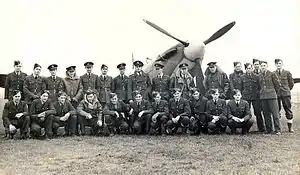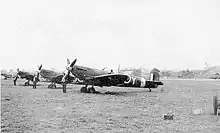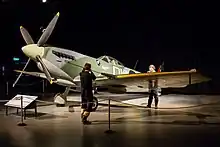No. 485 Squadron RNZAF
No. 485 (NZ) Squadron was a fighter squadron established for service during the Second World War. It was the first New Zealand squadron formed under Article XV of the Empire Air Training Plan. Although many of its flying personnel were largely drawn from the Royal New Zealand Air Force, the squadron, which operated Supermarine Spitfires, served in Europe under the operational and administrative command of the Royal Air Force.
| No. 485 (NZ) Squadron RAF | |
|---|---|
 Pilots of the Squadron with NZ High Commissioner Bill Jordan circa 1944 | |
| Active | 1 March 1941 – 26 August 1945 |
| Country | |
| Allegiance | |
| Branch | |
| Role | Fighter |
| Garrison/HQ | RAF Driffield, RAF Redhill |
| Motto(s) | Māori: Ka whawhai tonu ("We will fight on") |
| Equipment | Spitfire |
| Engagements | Second World War
|
| Insignia | |
| Squadron Badge | A demi Māori warrior holding a Taiaha |
| Squadron Codes | OU (Mar 1941 – Aug 1945) |
Background
In the mid-1930s, the Royal Air Force (RAF) was in the process of expanding and required an increasing number of suitable flying personnel. A number of schemes were implemented for New Zealanders to obtain short-service commissions in the RAF with the intention of then transferring to the Royal New Zealand Air Force (RNZAF) in the future. This led to over 500 New Zealanders serving in the RAF by the time of the outbreak of the Second World War.[1]
At around the same time there was discussion between the governments of Britain, Australia, Canada and New Zealand to facilitate the co-ordination of training of air crew for hostilities. This led to the implementation of the Empire Air Training Scheme (ETAS) in December 1939. Under this agreement, New Zealand committed to initially supply 880 full trained pilots for the RAF, with another 520 pilots being trained to an elementary standard annually. As each of the Dominion governments desired its personnel to serve together, the ETAS had a clause, Article XV, that allowed for the establishment of squadrons with personnel from the respective countries. In theory, the Dominions would supply the ground crew as well as flying personnel. However, in New Zealand's case, there was a reluctance to maintain RNZAF squadrons in Britain so the decision was made to allow for the formation of squadrons within the RAF designated as being New Zealand. These squadrons, known as Article XV squadrons, were formed around a cadre of New Zealand flying personnel already serving in the RAF but supplemented by newly trained pilots from the RNZAF, with administrative and ground crew being predominantly British.[2][3]
History

No. 485 (NZ) Squadron was the first of the New Zealand Article XV squadrons, formed on 1 March 1941 at RAF Driffield, in Yorkshire. Its first commander was Squadron Leader Marcus Knight, an experienced pilot from Dannevirke who had flown Hawker Hurricanes with No. 257 Squadron prior to being appointed commander of No. 485 Squadron. The two flight commanders were likewise experienced pilots, and among the other personnel were Pilot Officers Edwards Wells and Bill Crawford-Compton. After a period of training, the squadron became operational in mid-April, carrying out convoy patrols. Towards the end of the month, it moved to Leconfield.[4]
It was equipped with old Spitfire Mk Is for its "working up" period with No. 13 Group, which was carried out with no recorded fatalities. The Mk Is were exchanged for Mk IIs on 1 June 1941.[5] By July 1941 the squadron had scored its first victories, suffered its first combat fatalities and had moved to RAF Redhill, a frontline No. 11 Group RAF base to take part in offensive operations. One type of operation was fighter escort for "Circus" raids, in which a small number of RAF bombers (originally Bristol Blenheims and later Short Stirlings) were used as bait to draw up enemy fighters. [6]
Spitfire Vb

Starting in August 1941 Spitfire Mk Vbs began arriving. At least 20 of the Mk Vs had been paid for by a subscription fund in which citizens of New Zealand and Pacific Island 'Protectorates' could participate. Most of these aircraft bore the names of New Zealand Provinces stencilled on the fuel tank cover, just ahead of the cockpit (e.g.: W3579 'Southland II'.) [7]
In October 1941 the squadron moved to RAF Kenley, becoming a part of the Kenley Wing with 452 Sqn (RAAF). It was during this time that the formidable Focke-Wulf Fw 190 first appeared. The Spitfire V was outclassed and many fighter RAF squadrons suffered heavy casualties, 485 Sqn being no exception; the Merlin 60 powered Spitfire Mk IX would counter this imbalance, but it would be some months before this version arrived in numbers. The unit remained at Kenley until July 1942, when the squadron was withdrawn for rest in Kingscliffe, Northants in No. 12 Group RAF.[8]
The start of 1943 saw 485 Sqn, still equipped with Spitfire Vbs, back in 11 Group, this time based at RAF Mildenhall. In June of that year, a contingent of thirteen squadron pilots were detached to Greenock Scotland to practice takeoffs and landings on "dummy" aircraft carrier decks. They then moved to Ayr and flew Seafire Ibs from the training carrier HMS Argus.[9] The beginning of July 1943 saw a shift to Biggin Hill, one of Fighter Command's best-known bases. There the unit took over 611 Sqn's Spitfire IXBs.
Spitfire IX
From July through to the first week of November 1943 the Squadron was mostly engaged on offensive fighter "sweeps" (an operation to draw up enemy fighters, hopefully, to shoot them down in large numbers), and bomber escorts. On 22 August 485 Sqn. suffered its worst day; during a high cover escort mission for American Marauders two enemy fighter squadrons attacked head-on. Four 485 Sqn pilots were shot down[10] with two enemy aircraft shot down in return.
In November 1943 the squadron returned to 12 Group for a short rest, during which time the unit flew Spitfire Vbs.

RAF Hornchurch was the destination in February 1944, when 485 Sqn, again equipped with new Spitfire IXs, became part of 135 Wing with 122 Sqn and 222 Sqn. Preparations for D-Day were underway and 485 Sqn undertook bombing and air-gunnery practice with a new Mk IIC gyroscopic gunsight. There was little chance to try out the new gunsight in action before D-Day however, as the squadron was engaged in bomber escort and saw few enemy aircraft.[11]
Opportunities for air-to-air combat came on D-Day and on the week following when 485 Sqn. shot down a total of nine enemy aircraft with no losses; these were to be the last enemy aircraft shot down in combat.[12]
485 Sqn had become a fighter-bomber unit and moved to the continent in July 1944. Starting in France the unit moved through Belgium and the Netherlands. On 1 January 1945 485 Sqn, based at B65 Maldegem, Belgium lost eleven Spitfires on the ground when attacked by Bf 109s during Operation Bodenplatte. There were no pilot or ground crew casualties and new Spitfires were available the next day. From late February 1945 there was a temporary move to Cornwall where Typhoons were flown in preparation for a planned conversion to Tempests. A shortage of Tempests meant that this conversion didn't happen. Rweqiupped with Spitfire Mk XVIs (Spitfire XI powered by a Packard Merlin 266) 485 Sqn ended the war based at airfield B.109/Drope, Germany.[13] 485 Sqn was officially disbanded on 26 August 1945. The Squadron's motto is in Māori Ka whawhai tonu ('We will fight on').
The crest from this Squadron was adopted in the late 1960s as the official crest for the then formed RNZAF Strike Wing, based at RNZAF Base Ohakea, North Island, New Zealand. This wing incorporated No. 75 Squadron RNZAF (Vampires) and No. 14 Squadron RNZAF (Canberras). It is now the crest of No. 485 Wing, which parents all RNZAF operational flying units stationed at RNZAF Base Auckland.
Achievements
485 Squadron flew 9,997 sorties. The unit claimed 63 enemy aircraft destroyed. During the short period that the squadron was employed against ground targets pilots destroyed 70 motor vehicles and 5 railway engines. 24 DFCs or DFMs were won by members of the squadron. Several squadron members, after serving on 485(NZ) Sqn. became Squadron Leaders, Wing Commanders and Group Captains.
Preserved aircraft
.jpg.webp)
- Ex 485 Spitfire MkIXc, OU-V / ML407, in which Johnnie Houlton shot down a Junkers Ju 88 on D-Day.[14] Converted to a two-seat trainer for the Irish Air Corps, was restored by Nick Grace and is flown by his widow Carolyn.
- MkIXc MK732 has been restored in post-war Dutch colours as PH-OUQ. It flew with 485 Squadron as OU-Q/U "Baby Bea V" taking part in D-Day and Operation Market Garden and in the hands of Flying Officer Patterson shot down a Messerschmitt Bf 109 on 8 June 1944.
- Spitfire MkXVIe TE288 is preserved at the Royal New Zealand Air Force Museum at Wigram, painted in the unit's colours to represent an aircraft operating inside Germany shortly prior to VE day, (TE288 did not see active service. Was used in the movie Reach for the Sky (1956), the Douglas Bader story).
- Ex 485 Squadron Spitfires are also preserved in Dutch and Norwegian aviation museums, painted to represent aircraft of those nations.
See also
- New Zealand Article XV squadrons: for an explanation of the status and naming of these units.
References
Footnotes
- McGibbon 2000, p. 8.
- McGibbon 2000, pp. 156–157.
- Thompson 1953, pp. 209–211.
- Thompson 1953, pp. 211–212.
- Sortehaug & Listemann. No. 485 (N.Z.) Squadron 1941–1945. Morris, Gerard S. Spitfire, the New Zealand Story.
- 1103 sorties were flown on Spitfire Mk I and IIs, with seven E/A (Enemy/Aircraft) shot down and eleven Spitfires lost to all causes includes accidents (air and ground) and aircraft shot down. Four pilots were killed. Sortehaug & Listemann. No. 485 (N.Z.) Squadron 1941–1945. Morris, Gerard S. Spitfire, the New Zealand Story.
- A comprehensive account of these aircraft is given in Morris, Gerard S. Spitfire, the New Zealand Story. Also Sortehaug & Listemann. No. 485 (N.Z.) Squadron 1941–1945.
- During this period (8–41 to 7–42) of operations 485 Sqn. flew 2272 sorties, claimed 43 enemy aircraft and lost 31 Spitfires to all causes. 11 pilots were killed, 7 became POWs and 2 evaded capture. Sortehaug & Listemann. No. 485 (N.Z.) Squadron 1941–1945. Price, Alfred. Spitfire Mk V Aces 1941 – 1945.
- Morris 2000. Houlton 1985
- Two were captured (one severely injured), one killed and one evaded capture. The latter, Flt Sgt Leslie "Chalkie" White has a biography about his time on 485 Sqn. Braithwaite, Errol. Pilot on the Run. 1986
- Many of the Spitfire IXs flown by 485 Sqn were converted to carry a fixed armament of two 20 mm Hispano cannon and two .50 cal Browning machine guns; this was the first time the .50 cal Browning saw use on the Spitfire, which usually carried two 20 mm Hispano and four .303 Brownings. Morris, Gerard. Spitfire the New Zealand Story.
- From October 1943 through to January 1945 no 485 Sqn. aircraft were lost. 485 Sqn had in total 97 confirmed and probable claims. Sortehaug and Listemann. 2006
- In total 33 Spitfire IX & XVIs were lost to all causes (11 during "Bodenplatte", one XVI post-war). In return 34 enemy aircraft were confirmed and five probable. Sortehaug and Listemann. 2006
- Although claimed to be the first aircraft shot down on D-Day, there is evidence that Mosquito night fighters were successful that morning. There is a probability that Houlton shared this Ju 88 with another pilot of 485 Sqn. Morris, Gerard S. Spitfire, the New Zealand Story.
Bibliography
- Sortehaug, Paul and Listemann, Phil. No. 485 (N.Z.) Squadron 1941–1945. Boé Cedex, France: Graphic Sud, 2006. ISBN 2-9526381-0-1. (90 Pages)
- Houlton, Johnnie. Spitfire Strikes. London, UK: John Murray, 1985. ISBN 0-7195-4178-6.
- Halley, James J. The Squadrons of the Royal Air Force & Commonwealth, 1918–1988. Tonbridge, Kent, UK: Air-Britain (Historians) Ltd., 1988. ISBN 0-85130-164-9.
- Jefford, C.G. RAF Squadrons, A Comprehensive Record of the Movement and Equipment of all RAF Squadrons and their Antecedents since 1912. Shrewsbury, UK: Airlife Publishing, 1998 (Second edition 2001). ISBN 978-1-84037-141-3.
- McGibbon, Ian, ed. (2000). The Oxford Companion to New Zealand Military History. Auckland, New Zealand: Oxford University Press. ISBN 0-19-558376-0.CS1 maint: ref=harv (link)
- Morris, Gerard S. (2000). Spitfire: The New Zealand Story. Auckland, New Zealand: Reed Books. ISBN 0-7900-0696-0.
- Thompson, H. L. (1953). New Zealanders with the Royal Air Force. Official History of New Zealand in the Second World War 1939–45. I. Wellington, New Zealand: War History Branch. OCLC 270919916.
- Thompson, H. L. (1956). New Zealanders with the Royal Air Force. Official History of New Zealand in the Second World War 1939–45. II. Wellington, New Zealand: War History Branch. OCLC 300089346.
- Wells, Kevin W. (1984). An Illustrated History of the New Zealand Spitfire Squadron. Auckland, New Zealand: Hutchinson Group. ISBN 0-09-159360-3.
Further reading
- Rae, Jack. Kiwi Spitfire Ace. London, UK: Grub Street, 2001. ISBN 1-902304-78-0.
- Col. James R. Haun, Spitfire Wingman from Tennessee. (esp. Chapter 11) Stormwatch Press, 2006. ISBN 978-0-9790002-0-1.
- Price, Alfred. Spitfire Mk V Aces 1941 – 1945. London, UK: Osprey Publishing, 1997. ISBN 1-85532-635-3.
- Price, Alfred. Late Marque Spitfire Aces 1942 – 1945. London, UK: Osprey Publishing, 1995. ISBN 1-85532-575-6.
- Rawlings, John D.R. Fighter Squadrons of the RAF and their Aircraft. London: Macdonald and Jane's (Publishers) Ltd., 1969 (new edition 1976, reprinted 1978). ISBN 0-354-01028-X.
External links
| Wikimedia Commons has media related to No. 485 (NZ) Squadron RAF. |